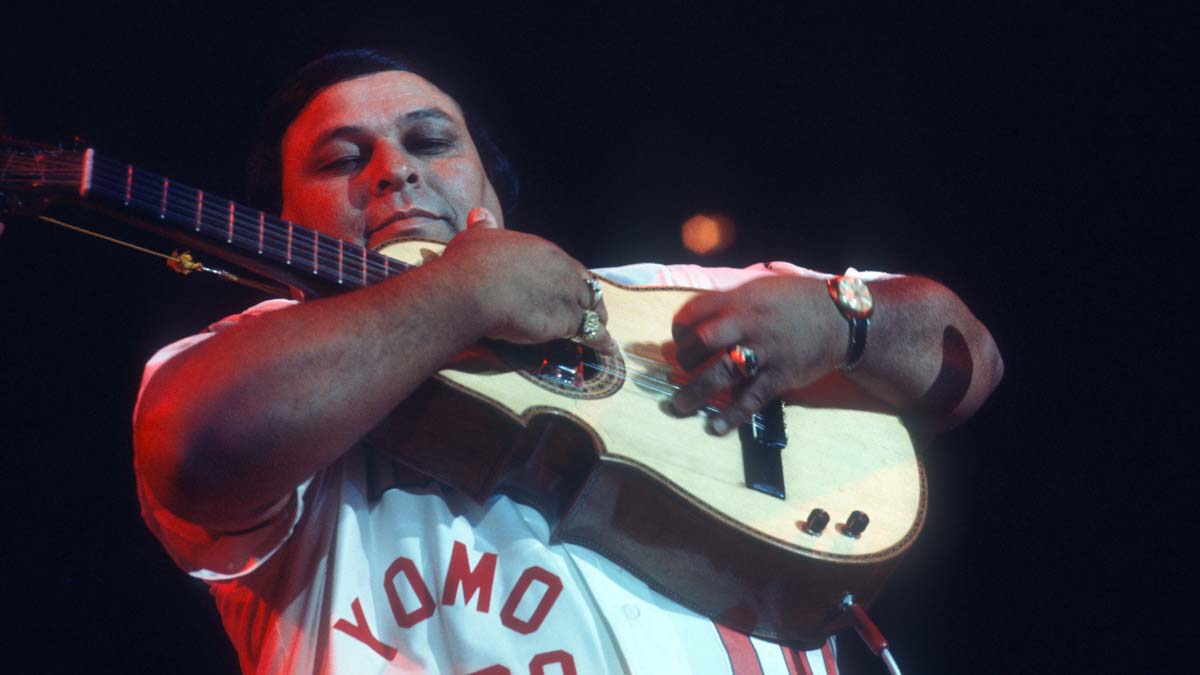
Yomo Toro, master of the cuatro (Puerto Rico’s 10-stringed, guitar-like instrument) has been a beloved cultural icon and musical maestro for more than forty years. A resident of New York City since 1956, he has never lost his jíbaro spirit and his delightful presence has pleased thousands of fans throughout the world, while his spectacular playing has astounded audiences throughout his lengthy and varied career.
Our collection opens with a greeting from Yomo himself, right off of his telephone answering machine! This uniquely “Yomo” moment, introducing us to his world of ebullient humor and musical whimsicality, was recorded by longtime friend Verna Gillis for the album El Espiritu Del Jíbaro.
Born in the town of Ensenada, in the Guanica municipality in Puerto Rico, Yomo’s father, also a cuatro player, was his first teacher. By the time he was a teenager Yomo was playing with many popular local groups, such as Los Delfis Del Sud. In 1953 he went to New York with Bury Cabán y Los 4 Aces and, after three years of going back and forth, finally settled in New York for good, in a humble apartment near Yankee Stadium, in the Bronx.
Throughout the ‘60’s Yomo played with groups such as Los Panchos and Ramito. His first solo recordings, such as Alma de Ramito for the Cotique label, reflect a thorough knowledge of Latin music: the trumpets in “Las Chismosas” are reminiscent of mariachi, and the rhythm is the lilting 6/8 of Argentine chacarera.
But even as Yomo performed the sentimental music of the time, beneath this conventional exterior lurked an adventurous spirit, ready to try anything from rock and roll to classical to disco to bluegrass. And it was the fever of Fania in the late ‘60’s and early ‘70’s that finally brought out this creative aspect of Yomo Toro.
In 1970 Yomo was invited to join Willie Colón and Hector Lavoe on their landmark Christmas release, Asalto Navideño. This groundbreaking album fused the music of the traditional Puerto Rican Christmas with the new wild urban salsa. On tracks such as “Aires De Navidad”, the ringing sound of Yomo’s cuatro mingled with the raw sound of the trombones and percussion, adding a note of nostalgia, a feeling of connection with the island home within the cold New York City winter. This album, with its non-Christmas-related hit, “La Murga Panameña”, became one of the best-selling salsa albums of all time. The following year Willie produced the follow-up album Asalto Navideño Volume 2. Also extremely popular, this album contains the wonderful Christmas track “Doña Santos”, whose traditional elements such as aguinaldos and seis are belied by a wacky album cover featuring Yomo as Santa, with Hector Lavoe and Willie Colón as Santa’s elves.
Several years later, in 1979, Yomo and Hector Lavoe reunited to record Feliz Navidad with Daniel Santos and Johnny Pacheco. Apart from its musical qualities, this album’s cover takes Fania’s artwork another step further into surrealism: Yomo dressed as Santa Claus hovers over Hector Lavoe, an enormous half-naked baby in a baby carriage. These three recordings fully established Yomo as the “King of Christmas” for the Puerto Rican people, a title he has comfortably carried for over thirty years.
As a member of the Fania All Stars, Yomo became part of a unique tribe which included Willie Colón, Hector Lavoe, Johnny Pacheco, Bobby Valentín, Roberto Roena, Ray Barretto, Larry Harlow, Cheo Feliciano and Ismael Miranda, artists whose souls were on fire with a new sound. When the Fania All Stars formed in 1971 he was an official member of the band, touring throughout the world.
He also recorded two solo albums for Fania Records: Romantico (featuring the iron-clad voice of his old friend Dalia Silva) and Música Para El Mundo Entero. Romantico brings Yomo back to his sentimental roots, weaving melodic improvisations around harmony-laden boleros, while Música Para El Mundo Entero is playful and experimental. This album features “Yomo Y La Evolución”, a musical journey with stops at merengue, Cuban son, Mexican hat-dance, flamenco, calypso, pasillo ecuadoreano, and boogie-woogie, plus a taste of Yomo’s famous solo from “Quítate Tu”, one of the Fania All Stars’ most ubiquitous hits.
On these albums Yomo displays his talents as an original songwriter, particularly of romantic ballads such as “No Quiero Ser Tu Amante”. His compositions, such as “El Lechón De Cachete” have appeared on many albums and it is a mark of his modesty that his work as a songwriter is rarely mentioned.
Yomo’s work with Willie Colón peaked with the album The Good, The Bad, The Ugly. A transitional album for Willie Colón, this was the last time he would record with Hector Lavoe, introducing Rubén Blades as both singer and writer on this album. The cover has a Spaghetti Western theme, with Yomo (The Good), Willie (The Bad) and Hector (The Ugly) dressed Pancho Villa-style. The danzón instrumental, “Doña Toña,” is dedicated to Willie’s grandmother and sets Yomo’s tuneful cuatro among elegant trombone and percussion arrangements.
In the late ‘80’s Yomo’s career took an important turn when he began to release solo albums on Chris Blackwell’s Island Records’ Mango imprint. Steered by world music producer/ pioneer Verna Gillis, with whom he shared a love of fusing diverse styles, Yomo recorded three albums as a “world music” artist. Funky Jíbaro, Gracias and Noveleo all reflect Gillis’ and Yomo’s never-ending search for common ground between different genres: disco, rock and roll, flamenco, reggae, all appear on these albums with varying degrees of success. Within this period he also recorded with stars such as Harry Belafonte, Paul Simon, David Byrne and Linda Ronstadt while maintaining his salsa chops with Larry Harlow and the Latin Legends and his own band featuring bassist Ruben Figueroa, Dalia Silva and other friends.
In 1996 Yomo recorded Celebremos Navidad for the independent label Ashé Records. Inspired by Asalto Navideño, producers Rachel Faro and Sammy Figueroa brought members of the legendary Puerto Rican band Batacumbele such as Jerry Medina, Eric Figueroa and Cachete Maldonado together with some of New York’s greatest salsa musicians such as Joe Santiago, Bobby Allende, Papo Vasquez, Jorge Gonzáles and Ralph Irizarry. Putting a modern sound to the traditional songs, Yomo still considers this his best album to date.
Since then he has continued to record and perform at a prodigious rate, with Larry Harlow and the Latin Legends Band, Marc Anthony, Gloria Estefan and many others. The Smithsonian Museum in Washington DC created an exhibit for him and a statue of Yomo stands in the plaza of his hometown. He appears regularly in the off-Broadway show “Sofrito”. His latest album, Espíritu Jíbaro, produced by longtime friend Verna Gillis, is an intriguing collaboration between Yomo and the extraordinary trombonist Roswell Rudd, supported by drummer Bobby Sanabria.
It is ironic that an artist who has brought so much joy to so many has had so much tragedy in his personal life. Plagued by bouts of depression, he has had to sustain the death of two of his children before their time. Since the death of his daughter at Christmas time in 2005, Yomo has performed his Christmas shows in black. This dark side is reflected in the song “Salve Mi Pueblo”, whose despairing words are in sharp contrast to the cheerful plena rhythm of the music.
And yet, Yomo always returns to the joyous energy of songs such as “Fuikiti” and “El Lechón De Cachete”. As all who know and love him are aware, Yomo’s buoyant and compassionate spirit always seems to rise above all chaos or sorrow. Yomo Toro is an inspiration and harbinger of joy in his music and his manner, truly embodying the spirit of “Sangre Latina”.
Compilation produced by Rachel Faro
Liner notes by Rachel Faro


